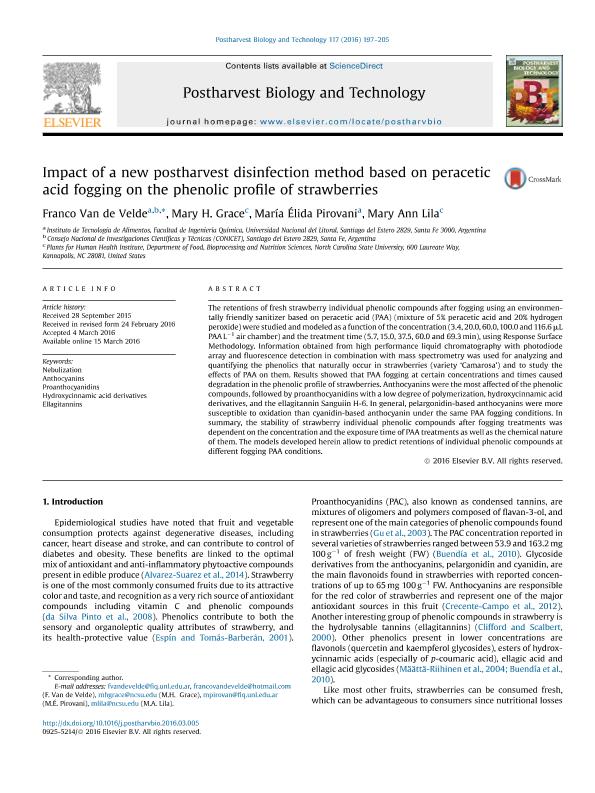Mostrar el registro sencillo del ítem
dc.contributor.author
Van de Velde, Franco

dc.contributor.author
Grace, Mary H.
dc.contributor.author
Pirovani, Maria Elida

dc.contributor.author
Lila, Mary Ann

dc.date.available
2018-10-16T18:14:55Z
dc.date.issued
2016-07
dc.identifier.citation
Van de Velde, Franco; Grace, Mary H.; Pirovani, Maria Elida; Lila, Mary Ann; Impact of a new postharvest disinfection method based on peracetic acid fogging on the phenolic profile of strawberries; Elsevier Science; Postharvest Biology and Technology; 117; 7-2016; 197-205
dc.identifier.issn
0925-5214
dc.identifier.uri
http://hdl.handle.net/11336/62452
dc.description.abstract
The retentions of fresh strawberry individual phenolic compounds after fogging using an environmentally friendly sanitizer based on peracetic acid (PAA) (mixture of 5% peracetic acid and 20% hydrogen peroxide) were studied and modeled as a function of the concentration (3.4, 20.0, 60.0, 100.0 and 116.6 μL PAA L-1 air chamber) and the treatment time (5.7, 15.0, 37.5, 60.0 and 69.3 min), using Response Surface Methodology. Information obtained from high performance liquid chromatography with photodiode array and fluorescence detection in combination with mass spectrometry was used for analyzing and quantifying the phenolics that naturally occur in strawberries (variety 'Camarosa') and to study the effects of PAA on them. Results showed that PAA fogging at certain concentrations and times caused degradation in the phenolic profile of strawberries. Anthocyanins were the most affected of the phenolic compounds, followed by proanthocyanidins with a low degree of polymerization, hydroxycinnamic acid derivatives, and the ellagitannin Sanguiin H-6. In general, pelargonidin-based anthocyanins were more susceptible to oxidation than cyanidin-based anthocyanin under the same PAA fogging conditions. In summary, the stability of strawberry individual phenolic compounds after fogging treatments was dependent on the concentration and the exposure time of PAA treatments as well as the chemical nature of them. The models developed herein allow to predict retentions of individual phenolic compounds at different fogging PAA conditions.
dc.format
application/pdf
dc.language.iso
eng
dc.publisher
Elsevier Science

dc.rights
info:eu-repo/semantics/openAccess
dc.rights.uri
https://creativecommons.org/licenses/by-nc-sa/2.5/ar/
dc.subject
Anthocyanins
dc.subject
Ellagitannins
dc.subject
Hydroxycinnamic Acid Derivatives
dc.subject
Nebulization
dc.subject
Proanthocyanidins
dc.subject.classification
Agronomía, reproducción y protección de plantas

dc.subject.classification
Agricultura, Silvicultura y Pesca

dc.subject.classification
CIENCIAS AGRÍCOLAS

dc.title
Impact of a new postharvest disinfection method based on peracetic acid fogging on the phenolic profile of strawberries
dc.type
info:eu-repo/semantics/article
dc.type
info:ar-repo/semantics/artículo
dc.type
info:eu-repo/semantics/publishedVersion
dc.date.updated
2018-10-11T17:40:27Z
dc.journal.volume
117
dc.journal.pagination
197-205
dc.journal.pais
Países Bajos

dc.journal.ciudad
Amsterdam
dc.description.fil
Fil: Van de Velde, Franco. Universidad Nacional del Litoral. Facultad de Ingeniería Química. Instituto de Tecnología de los Alimentos; Argentina. Consejo Nacional de Investigaciones Científicas y Técnicas. Centro Científico Tecnológico Conicet - Santa Fe; Argentina
dc.description.fil
Fil: Grace, Mary H.. University of North Carolina; Estados Unidos
dc.description.fil
Fil: Pirovani, Maria Elida. Universidad Nacional del Litoral. Facultad de Ingeniería Química. Instituto de Tecnología de los Alimentos; Argentina
dc.description.fil
Fil: Lila, Mary Ann. University of North Carolina; Estados Unidos
dc.journal.title
Postharvest Biology and Technology

dc.relation.alternativeid
info:eu-repo/semantics/altIdentifier/url/http://www.sciencedirect.com/science/article/pii/S092552141630028X
dc.relation.alternativeid
info:eu-repo/semantics/altIdentifier/doi/https://doi.org/10.1016/j.postharvbio.2016.03.005
Archivos asociados
